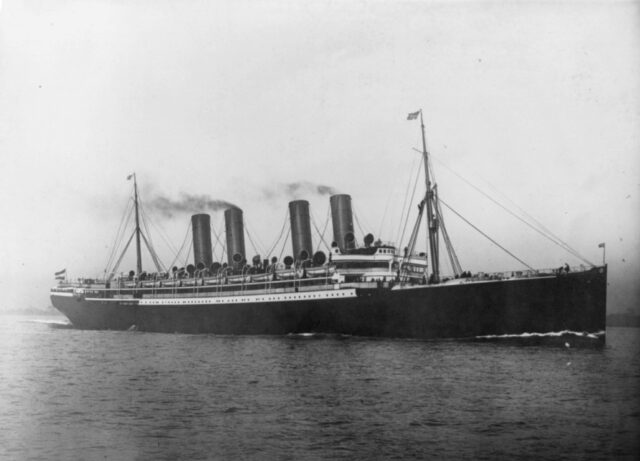The RMS Mauretania (1906) was remarkably similar in appearance to the famed RMS Titanic, although the former embarked on her maiden voyage on November 16, 1907 – five years before Titanic. At the time, the ocean liner was the fastest and largest to sail the high seas, showing the ever-evolving possibilities of luxury ocean travel.
SS Kaiser Wilhelm der Grosse

The story of the RMS Mauretania begins with the SS Kaiser Wilhelm der Grosse, a German ocean liner that was once considered the world’s fastest and largest ship. When measured in 1897, the vessel was able to reach a top speed of nearly 26 MPH. By doing so, she stole the title of the fastest transatlantic passenger liner from Cunard Line’s RMS Campania.
Kaiser Wilhelm der Grosse embarked on her maiden voyage in September 1897 and remained in service for nearly 20 years. Her time transiting passengers across the Atlantic Ocean was pretty uneventful, aside from a refit in 1913 that saw her turned into an auxiliary cruiser via the addition of cannons.
A year later, Kaiser Wilhelm der Grosse became a target of the British, as part of the First World War. While off the coast of the Spanish Sahara, she was attacked by the HMS Highflyer (1898). When the former ocean liner ran out of ammunition, her crew decided to scuttle her, as opposed to letting the vessel fall into enemy hands.
The wreck was discovered in 2013.
Intending to surpass the SS Kaiser Wilhelm der Grosse

During this same period, the International Mercantile Marine Company, owned by J.P. Morgan, acquired the famed British shipping company Oceanic Steam Navigation Company, commonly referred to as the White Star Line. It was Cunard Line’s primary rival and owned the RMS Titanic.
In 1902, the British government decided to build its own high-speed vessel, with the intention it be even faster than the SS Kaiser Wilhelm der Grosse. Construction of the new ocean liner was a joint venture between Cunard and the government. With a loan of £2.6 million, the building of two seafaring ships commenced. Their names were the RMS Mauretania and Lusitania.
They were both designed by master naval architect Leonard Peskett, who had help from both Swan Hunter & Wigham Richardson and John Brown and Company, who made sure Mauretania could surpass Kaiser Wilhelm der Grosse‘s in speed. The first design appeared in an issue of Shipbuilder’s magazine and, in 1904, construction commenced.
Design of the RMS Mauretania (1906)

By 1906, the RMS Mauretania was complete. Anne Innes-Ker, the Duchess of Roxburghe, had the honor of launching the ship – at the time the largest the world had ever witnessed.
The interior of the vessel, designed by British architect Harold Peto, was as impressive as her exterior. It featured 28 types of wood, large amounts of marble and plentiful tapestries. People were so impressed that they began to gossip, and a rumor was spread that the wood paneling had been carved by no less than 300 Palestinian craftsmen (this is unlikely to be true).
The dining room was adorned with an impressive skylight, and the ocean liner was equipped with several elevators – a rarity at the time.
RMS Mauretania‘s (1906) early years – including the Titanic disaster

In 1907, the RMS Mauretania officially became the world’s fastest ship, and, five years later, was in the middle of a journey from Liverpool to New York when the RMS Titanic embarked on her maiden voyage, which turned out to be the ocean liner’s last. On April 15, 1912, as Titanic was going through her darkest moments, Mauretania was docked at the port of Queenstown, in Ireland. She was carrying the cargo manifest of Titanic.
Just under a year after the sinking of the Titanic, King George V and Mary of Teck were given a tour of Mauretania.
Transporting troops during World War I

The RMS Mauretania wasn’t without her own dark moments. In 1914, four people were killed and six more suffered injuries in an explosion caused by a burst gas cylinder. The ocean liner was quickly repaired and returned to service two months later.
From 1914-19, Mauretania was ordered to be turned into an armed merchant cruiser, but was deemed unsuitable due to her large size. She was, in turn, transformed into a troop ship and tasked with transporting soldiers during the Gallipoli Campaign. During this time, she narrowly missed becoming the victim of a German U-boat.
Throughout the First World War, Mauretania, by this time known as the HMS Tuberose, alternated between serving as a troop and hospital ship. She even received dazzle camouflage, in an attempt to protect her from enemy attacks while men were aboard.
Post-war service and scrapping

After World War I, the RMS Mauretania was returned to service as an ocean liner, traveling across the Atlantic on what was an incredibly busy schedule. She was among the most popular passenger vessels and continued to offer services during the Great Depression – in particular, six-day cruises between New York and Halifax, Nova Scotia.
More from us: Battery 223: The Abandoned WWII-Era Military Fortification on the New Jersey Coast
Mauretania was deemed surplus following Cunard Line’s merger with White Star Line and, in 1934, was laid up, ending 28 years of dedicated service. Her furnishings were subsequently auctioned off and the vessel scrapped, despite the protests of passengers who’d traveled aboard the ocean liner over the years, including US President Franklin D. Roosevelt.
